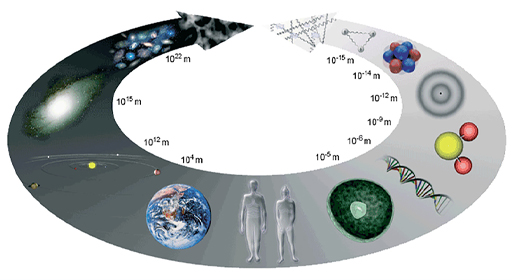1 Research areas and orders of magnitude
The scientific word for discrete, as opposed to continuous, values is ‘quantum’. This is often portrayed as the world of the very small, but what comes to mind when you think of this word? If you do a Google search, you will find over 600 million matches (Figure 1).
It may surprise you that quantum experiments are being done on the ISS. However, it is ideally suited as a platform to look out to the rest of the Universe and look down at Earth.
You already know about some of the scientific research taking place on the ISS. But did you know that it offers the unique environment of being humanity’s only permanent microgravity laboratory? For example, colloids (tiny particles in liquids) can be studied on the ISS where their structures are controlled by ‘quantum forces’ in a microgravity environment. These effects were predicted over 30 years ago and were first observed in 2008.
You first need to appreciate the change in size scales and the best way to do this is by using a logarithmic scale. Remember in Week 2 you were introduced to a similar scale in the context of heart rates and life expectancy.
Powers of ten are used to quantify these sizes from the very large to the very small. These powers are interpreted on a logarithmic scale and they give a feeling for the ‘order of magnitude’.
If you need to refresh what these powers of ten mean, look again at Section 5 in Week 1 [Tip: hold Ctrl and click a link to open it in a new tab. (Hide tip)] .
Figure 2 illustrates the vast changes in scale from the sizes of clusters of galaxies (1022 m) through to humans and down to subatomic particles and beyond (10–15 m). This is a huge range! In ‘real numbers’ it goes from ten thousand million million million metres down to 0.000 000 000 000 001 m.
Now use Figure 2 to help you complete Activity 1.
Activity 1 Size scales
a.
10–6 m
b.
1060 m
c.
10–600 m
The correct answer is a.
Answer
The rough size of a DNA helix is 10–6m.
a.
1014 m
b.
10140 m
c.
10–140 m
d.
10–1 m
e.
10–14 m
The correct answer is e.
Answer
The rough size of the nucleus of an atom is 10–14m.
a.
1015
b.
1012
c.
1022
d.
1018
The correct answer is c.
Answer
The smallest object is 10–15m and the largest object is 1022m.
You will now look at quantum science in general.


